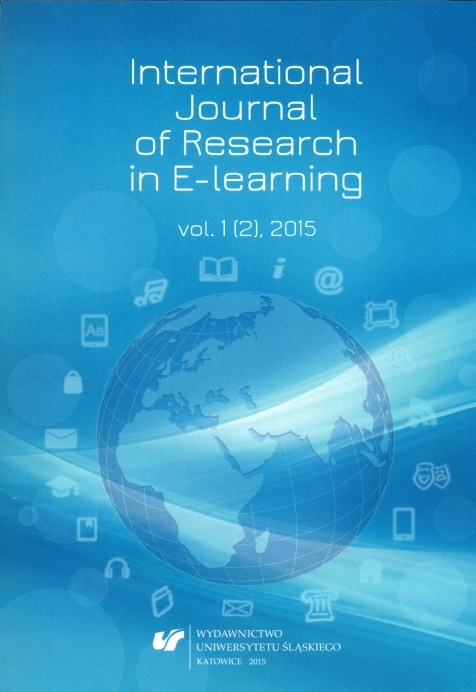Adobe Captivate website http://www.adobe.com/products/captivate/features.html. Adobe Connect website http://www.adobe.com/pl/products/adobeconnect.html. BBFlashBack website http://www.bbsoftware.co.uk/BBFlashBack_FreePlayer. aspx. Boyle, T. (1997). Design for multimedia learning. London: Prentice Hall.
Google Scholar
Boyle, T. (2002). Towards a theoretical base for educational multimedia design. Journal of Interactive Multimedia in Education, (2). Retrieved from www-jime.open.ac.uk/2002/2, http://www-jime. open. ac.uk/articles/10.5334/2002-2/.
Google Scholar
Boyle, T. Principles for the selection and integration of educational multimedia materials. Accessed 26 January 2016. Retrieved from http://core.ac.uk/download/pdf/14300.pdf.
Google Scholar
Camtasia distributer website https://www.techsmith.com/camtasia.html.
Google Scholar
Effective presentations. A toolkit for engaging an audience. Accessed 15 January 2016. Retrieved from https://www.medicalteams.org/docs/default-source/resource-center/effective-presentation- toolkit.pdf?sfvrsn=2.
Google Scholar
Gallo, C. How to be insanely great in front of any audience. The presentation secrets of Steve Jobs. Accessed 15 January 2016. Retrieved from http://www.presensatie.nl/wp-content/ uploads/2014/08/Presentation-Secrets-Of-Steve-Jobs.pdf.
Google Scholar
Greenberg, A. D., & Zanetis, J. (2012). The impact of broadcast and streaming video in education. San Jose. Accessed 15 January 2016. Retrieved from http://www.cisco.com/web/strategy/docs/education/ciscovideowp.pdf.
Google Scholar
Hansch, A., Newman, C., Hillers, L., Shildhauer, T., McConachie, K., & Schmidt, P. (2015). Video and online learning: Critical reflections and findings from the field. Accessed 15 January 2016. Retrieved from http://papers.ssrn.com/sol3/papers.cfm? abstract_id=2577882.
Google Scholar
Higgison, C. (Ed.). (2000). Online tutoring e-book. This document has been published by OTiS (the Online Tutoring Skills Project) based at: http://www.fredriley.org.uk/callhull/otis/t2-06.pdf The Institute for Computer Based Learning, Heriot-Watt University, Edinburgh, EH14 4AS and The Centre for Open and Distance Learning, The Robert Gordon University, Schoolhill, Aberdeen, AB10 1FR. ISBN 0-9540036-3-2.
Google Scholar
Hypercam distributor website http://www.hyperionics.com/. IRNet project website www.irnet.us.edu.pl.
Google Scholar
Jobs, S. Steve Jobs on Pixar Success, Hollywood & Storytelling – D3 2005 [HQ]. Accessed 26 February 2016. Retrieved from https://www.youtube.com/watch?v=Oi2VlxdNuWU.
Google Scholar
Liles, M. (2012, April 10). [Web log message]. Accessed 26 February 2015. Retrieved from http:// blog.discoveryeducation.com/blog/2012/04/10/flip-your-classroom-with-discovery-education.
Google Scholar
Muñoz, J. M., Rubio, S., & Cruz, I. (2015). Strategies of collaborative work in the classroom through the design of video games. Digital Education Review, (27), 69–84. Accessed 15 November 2015. Retrieved from http://greav.ub.edu/der.
Google Scholar
Pitman, R. (1989). Pushing pause: Hesitations about the video revolution. Library Journal, November, 34–37.
Google Scholar
Reis, A., (2008). New technologies and didactics in new methodologies environment. Innsbruck University Press. ISBN 9733902571670.
Google Scholar
Reis, A., Making presentations and didactic videos. Accessed 15 November 2015. Retrieved from ar-en-wp4-01present.blogspot.com.
Google Scholar
Reflections about scenarios for the school of the future. Accessed 25 June 2015. Retrieved from http:// areis-en-schooloffuture.blogspot.pt/.
Google Scholar
Ruffini, M. F. Screencast integration – flip and face/flip. Accessed 15 January 2016. Retrieved from http://assets.techsmith.com/Docs/pdf-landingpages/Screencast_Integration_ Models_techsmith. pdf.
Google Scholar
Stiles, J. (2008). Brain development. Accessed 15 November 2015. Retrieved from http://www. youtube.com/ watch?v=FugrcVhi2tg?.
Google Scholar
SURFnet/Kennisnet. (2011). Next generation video.
Google Scholar
Tips for designing effective educational videos. Accessed 10 October 2015. Retrieved from http:// federation.edu.au/staff/learning-and-teaching/clipp/elearning-hub/video-recording/tips-for-designing-video.
Google Scholar
WEiNoE Faculty distance learning platform http://el.us.edu.pl/weinoe.
Google Scholar
Woolfitt, Z. (2014). Catching the wave of video teaching. Supporting lecturers in the tourism team Inholland Diemen in developing video teaching skills (Master’s thesis). Inholland University of Applied Sciences. Retrieved from http://www.inholland.nl/onderzoek/lectoraten/elearning/ inzet+video+en+weblectures/.
Google Scholar
Woolfitt, Z. (2015). The effective use of video in higher education. Inholland University of Applied Sciences. Accessed 15 February 2016. Retrieved from https://www.inholland.nl/media/10230/ the-effective-use-of-video-in-higher-education-woolfitt-october-2015.pdf
Google Scholar


